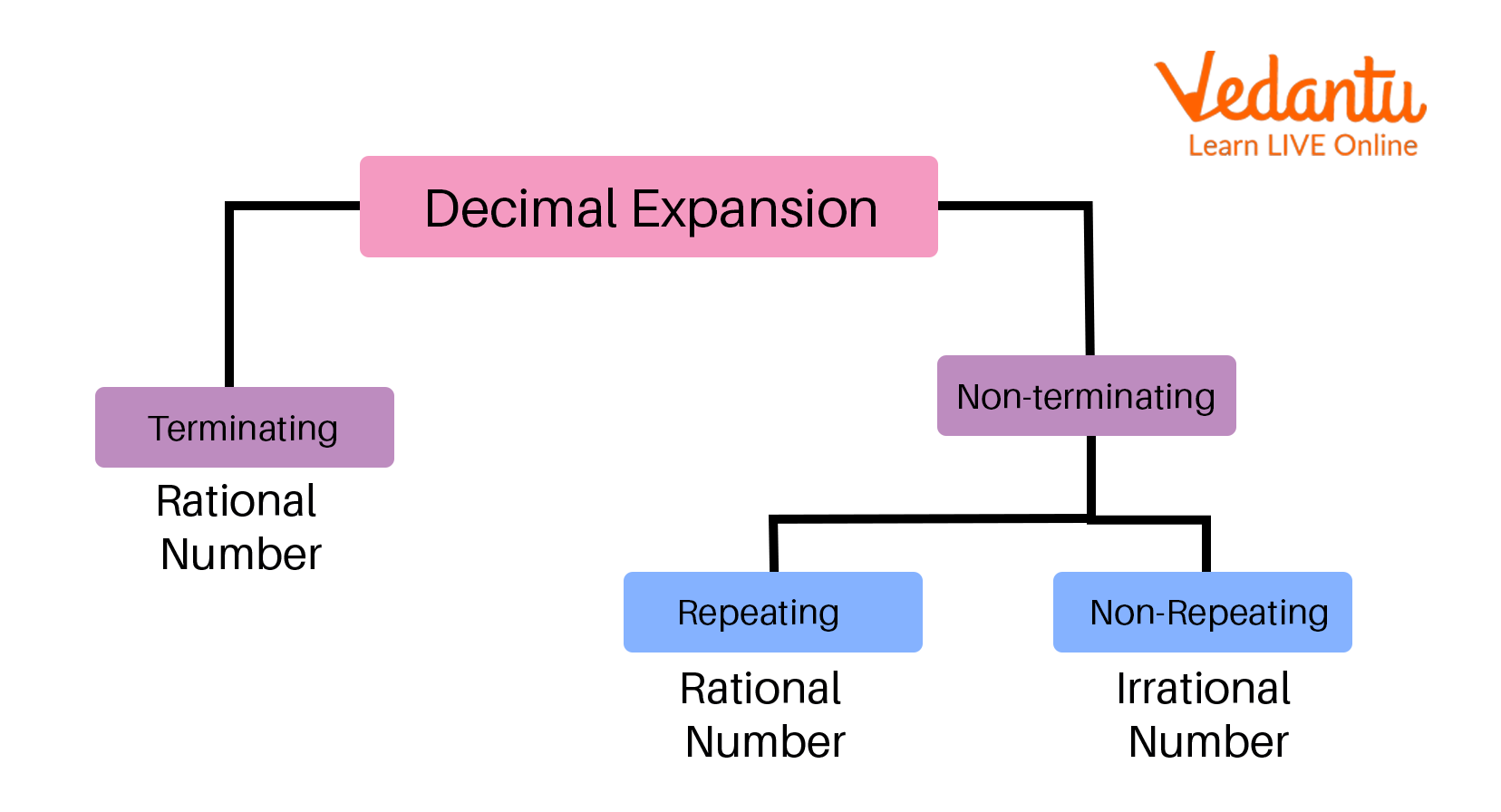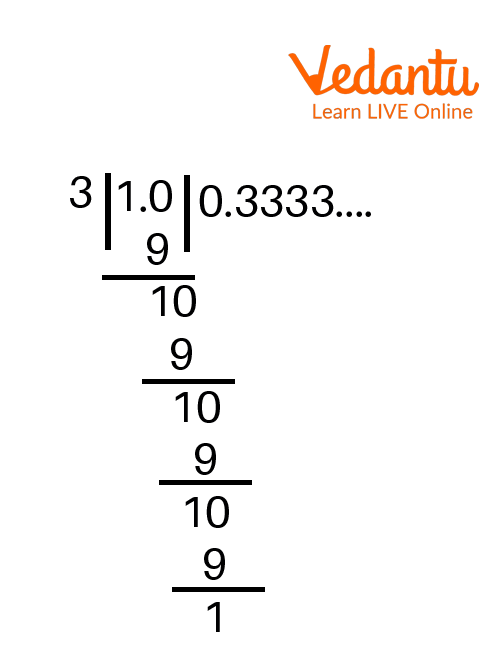




Introduction of Decimal Expansion of Rational Numbers
Let's first define rational numbers before discussing how they are represented when expanded to decimal form. The term "rational number" refers to any number that can be expressed as
Examples:
Decimal Expansion of the Rational Number
The decimal expansion of a rational number is obtained by dividing the numerator by the denominator of the rational number.

Decimal Expansion
Types of Decimal Expansion
By dividing a rational number's numerator by its denominator, one can get the decimal expansion of a rational number. Two types of decimal numbers may result from this process.
Terminating Decimal Numbers
Non-Terminating Decimal Numbers
Terminating Decimal Numbers: Terminating decimal numbers are those decimal numbers with a limited number of digits following the decimal point. These decimal integers can be expressed in the
For example,
Here,
Non-terminating Decimal Numbers: Non-terminating decimal numbers are those that have an endless number of digits following the decimal point.
Non-terminating decimal numbers include, for instance,
How to Expand Rational Numbers in Decimals
Whole numbers, natural numbers, and integers are all examples of rational numbers because they can all be expressed in
Example: Find the decimal expansion of
Let's divide the numerator by the denominator.

Decimal Expansion
In this case, the divisor is
Terminating Decimal Expansion of Rational Numbers
When the digits after the decimal point are either terminated or finite, a number has a terminating decimal expansion. The decimal expansion for the fraction
Non-terminating Decimal Expansion of Rational Numbers
The term "repeating" or "recurring" indicates that the repetition of the decimal values leads to a recognisable pattern that is easy to recognise, even though the decimal places in this expansion will never end and carry on forever. The expression

Non-terminating Decimal Expansion
Irrational Numbers Decimal Expansion
The use of decimal numerals to indicate an irrational number's most accurate value is referred to as the "decimal representation of irrational numbers." Non-terminating decimals with non-repeating digits are used to represent irrational numbers. For instance: Let's consider
Attempting to write
Interesting Facts
Any number that can be stated as a fraction is rational.
The examples include rational numbers: whole numbers, integers, fractions of integers, and terminating decimals.
Rational numbers also include recurring decimal patterns and non-terminating decimals.
A fraction is regarded as negative if it has a negative sign, either in the numerator, the denominator, or the fraction itself.
Solved Examples
Example 1: How would you characterize the prime factorization of the denominator of 42.123456789?
Solution: Since 42.123456789 is a decimal number with a terminating expansion, its denominator has the form
Hence, it has prime factorisation in the terms of 2 and 5.
Example 2: How many digits does the rational number
Solution: Let's use a whole number as the denominator.
The supplied rational number thus comes to an end at six decimal digits.
Practice Questions
Which of the following is the decimal representation of
None of these
0 is not a
Rational number
Irrational number
Whole number
Natural number
Answers
(A)
(D)
Summary
Let's summarise everything we've learnt in this article. Fractions can be used to represent rational numbers. Decimal numbers come in two varieties: repeating and non-repeating for the terminating and non-terminating numbers, respectively. Rational numbers are real numbers that repeat or terminate. For further information on rational numbers and their decimal expansions, have a look at some of the cases that have been solved and are provided in this article.
FAQs on Decimal Expansion of Rational Numbers
1. What purpose do rational numbers serve?
As integers alone cannot accurately express many quantities or measures, rational numbers are required. The most common usage of rational numbers is the measurement, whether it is of length, mass, time, or other quantities. When a farmer produces and wants to sell a portion of a bushel of wheat or when a worker needs a portion of a pound of copper, rational numbers are required. Rational numbers are used for all computations on digital computers.
2. What is the difference between finite and infinite decimal expansion?
There is a clear end in a finite decimal expansion. Let's take the fraction ½ the decimal expansion of which is 0.5(non-terminating). The terminating decimal is the 5 in the tenths place digit. An easy example is 1/3. Its decimal expansion is 0.3333, or an example of an infinite decimal expansion, in which the bar represents that the digit repeats forever.
3. When to use Decimal Expansion?
A fancy way of finding a number's decimal expansion is putting it into a decimal form. Put a bar over the digits that repeats and keep a track of the decimals. Convert between decimals and fractions. Recognise when a number has a terminating decimal expansion.
4. What is a terminating and non-terminating decimal?
Terminating decimals are those decimal numbers that have a finite number of digits that means after the decimal point and also after a certain number of repetitions in number comes to end.
In non-terminating decimals, the number does not come to an end. Non-terminating decimals have an infinite number of digits.
5. What are repeating and non-repeating decimals?
Repeating decimals are those numbers in which a specific number repeats uniformly after a decimal point. There is no uniform repetition of a number in non-repeating decimals.
6. Where can I find concept pages of my syllabus topics?
You can find concept pages of your syllabus topic on the official website of Vedantu and can also download the app from Play Store. The experts on Vedantu provide you with detailed explanations as per the subject, topic and chapters. Vedantu also provides a number of learning aids that can be helpful in the preparations of academic database competitive exams.
7. What are real numbers?
Real numbers are a collection of numbers that do not contain any imaginary values and are made up of all positive integers, negative integers, fractions, and decimal values. R is often used to indicate it. In other words, a real number is any number that comes to mind, with the exception of complex numbers. Real numbers include, for instance, 3, 1.533,























